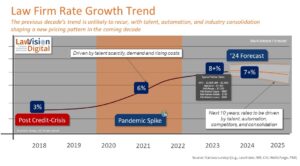As we usher in 2024, the echoes of 2023’s law firm successes and challenges still linger. Last year, we observed mixed demand, gnawing expenses, the AI frenzy, and talent scarcity. In that tumultuous terrain, I frequently wrote about the crucial role of effective pricing strategy and the idea that we may be in the later stages of a decade-long rate increase cycle, averaging 6 to 8 percent annually.[1]

Perfecting a pricing strategy remains increasingly critical, especially as economic uncertainties loom and we await a potential AI and innovation surge. This forthcoming wave is poised to alter law firm pricing models in the coming years fundamentally.
As we sit in January, the winds have shifted slightly. Inflation is cooling, the talent squeeze is loosening, and the AI frenzy is becoming more tactical, shedding some of its apocalyptic projections. Yet, amidst this change, one truth remains stark: law firm strategies must adapt to stand out.
Data-driven firms are no longer a futuristic aspiration but an essential survival tool. Effective rate and pricing management are the cornerstone of adaptation, growth, and innovation in this dynamic landscape.
If you have designed a thoughtful market-aligned rate strategy for 2024, congratulations! But the battle isn’t won there. Victory hinges on follow-through and execution. This isn’t just about spreadsheets, crunching numbers, and crafting proposals; it’s about organizational agility, inspiration, clear communication, performance transparency, and a laser focus on client value.
Therefore, today, we delve into the execution trenches, exploring how to transform your pricing strategy from blueprint to reality.
Strategic Execution: More Than Just Setting Prices
Execution is the lifeblood of a rate strategy. It turns theoretical price points into practical, actionable strategies that resonate with clients and ensure the firm’s profitability. This involves a series of deliberate actions and continuous adjustments, ensuring that the firm not only sets but lives by its value-driven pricing.
Therefore, as detailed below, a guiding operating framework is needed to achieve optimal rate performance. This begins with what I call “pricing with purpose,” accompanied by a strategic pricing plan.
The Criticality of a Strategic Pricing Plan and Firm Alignment
It is imperative to highlight the criticality of a strategic pricing plan and ensure firm alignment and understanding of the plan. One of the fundamental errors firms make is thinking about rates as a passive activity. Rates and pricing strategies are at the core of a law firm’s success and require proactive management and alignment with the firm’s broader strategic objectives. A well-conceived pricing strategy reflects the value of the services provided. It ensures that all firm members, from the top leaders to the individual attorneys, understand and support the approach. This alignment is crucial for the successful execution of any rate strategy.
Communication Creates Internal Buy-In and Client Engagement
Effective communication and consensus-building must originate within your firm, engaging partners, fellow lawyers, and professionals and seamlessly integrate with your client interactions. It is essential to foster open and transparent dialogue with your team and clients regarding any changes in billing rates and actively involve them in shaping your pricing strategies. Implementing pricing isn’t about opposing client interests; it’s about working together in good faith to ensure mutual understanding of the value provided. This approach isn’t simply about justifying expenses but engaging clients in the pricing dialogue, helping them perceive and appreciate the value behind the rates. Effective execution guarantees that every invoice and rate discussion underscores the firm’s dedication to delivering value with utmost transparency.
Governance: The Role of Pricing Leaders
The governance of rate execution is pivotal, with pricing leaders playing a crucial role as evangelists, advisors, and influencers of positive change within firms. These individuals are not just figureheads; they are the driving force behind the successful implementation of pricing strategies. They must be deeply embedded in the firm’s culture and operations, advocating for the importance of strategic pricing and guiding the firm through the complexities of execution. Importantly, this group must include lawyers who understand the nuances of legal services and can bridge the gap between pricing strategies and legal practice. Their involvement ensures that rate management is not just a financial exercise but an integral part of the firm’s service delivery and market position.
Adaptive Forward-Looking Pricing Models
Firms must be agile, adapting their pricing models to reflect changes in client needs and market conditions. This does not mean discounting but introducing new pricing approaches that best align risk and value between firms and clients (sometimes justifying a higher rate rather than a discount). Execution in this context means regularly revisiting and adjusting pricing structures, being responsive to feedback, and staying ahead of industry trends. This adaptability is key to maintaining relevance and competitiveness.
Technology Integration
Efficient rate execution is underpinned by technology. Technology streamlines operations and provides the data necessary for informed decision-making, from automated billing systems to AI-driven market analysis tools to understanding industry benchmarks. Execution means integrating these tools seamlessly into the firm’s pricing strategy.
Training for Performance and Personal Connection
A successful execution plan requires that your lawyers understand and support the firm’s pricing strategy. Continuous training ensures that everyone, from partners to associates, can articulate the value behind the rates and engage effectively with clients. Execution is about empowering the team to be ambassadors of the firm’s value proposition.
Note that this crucial area includes a deep understanding of pricing ideas and a culture that shares experiences and best practices. Market case studies are integral to helping lawyers understand that this is not an individual isolated exercise but a harmonized firm motion.
Monitoring and Course Correction
Executing a rate strategy is an ongoing process. It requires regular monitoring to gauge effectiveness, client satisfaction, and financial performance. Firms must be proactive, ready to make course corrections, and fine-tune their strategies. This agility ensures that the firm remains aligned with its goals and market demands. Monitoring progress and adjusting also provides transparency and accountability, enabling lawyers to learn that this is an essential program for the firm and that they are being given data to help them achieve their goals.
Emphasizing Execution in 2024
As we navigate through 2024, the emphasis on execution in rate management is more pronounced than ever. Law firms must move beyond setting rates to implementing dynamic, responsive, and transparent pricing strategies. It’s about clear communication, adaptive pricing, technology integration, continuous training, and regular monitoring. Firms that master the art of execution will not only navigate the complexities of the current market but will also set themselves up for sustained success in the future. It is not easy, but with a firm focus on execution and strong leadership, the path to success is clearer.
Of course, I’m always available to discuss these points with you. If you’d like to book a free consultation, you can do so here: Book Time Now.
[1] As I wrote in late 2023, our best forecasts for rate increases in 2024 remain on track with recent years, 7 to 8 percent.
Mark Medice is LawVision’s Strategic Pricing, Profitability and Data Science Principal.
Posted In
